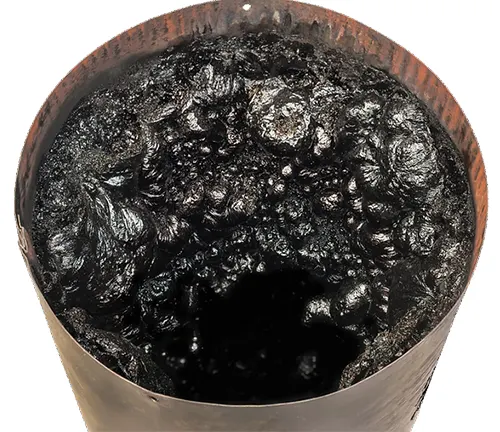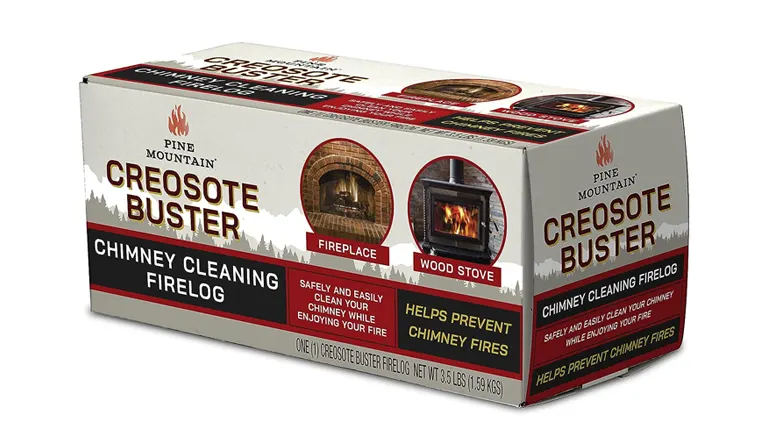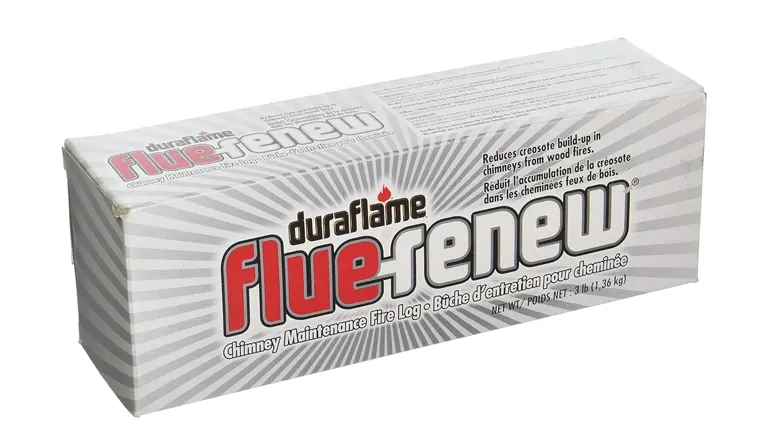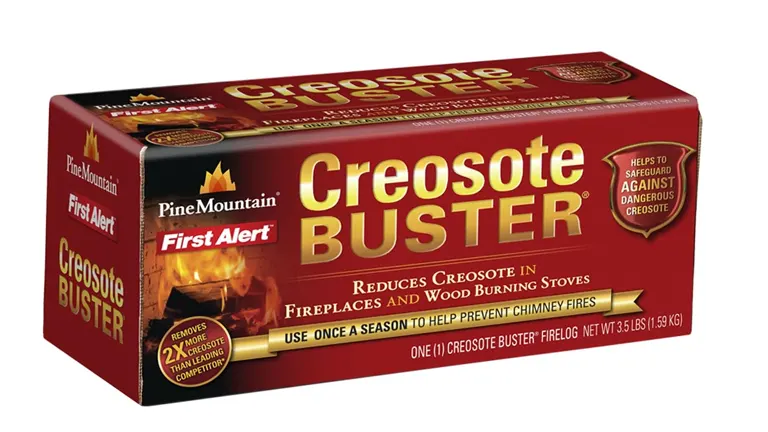Best Creosote Logs of 2024
- November 14, 2023
- 2 comment
Ensuring the safety and efficiency of your wood-burning fireplace or stove is essential, and managing creosote buildup is a key part of this maintenance. Creosote, a combustible byproduct of burning wood, poses a significant risk if it accumulates in your chimney. Recognizing this, our team has diligently researched and tested a range of products to find the best creosote logs available. These logs are designed to not only reduce creosote buildup but also to make the maintenance of your chimney simpler and more effective.

In this article, we’ll share our findings on the top creosote logs that stand out for their efficacy, ease of use, and environmental friendliness. Our goal is to provide you with reliable options that ensure your fireplace or stove remains a safe and enjoyable part of your home. Stay tuned for our in-depth reviews and recommendations, tailored to help you maintain a clean and safe chimney with minimal hassle.
List of Best Creosote Logs:
- Duraflame 2903 Flue Renew Firelog
- Pine Mountain Creosote Buster
- Creosote Sweeping Log
- Pine Mountain 4152501500 First Alert Creosote Buster
What is Creosote?

Creosote is a dark, viscous byproduct formed when wood or other organic materials are incompletely burned, commonly found in the chimneys of fireplaces and wood stoves. It consists of various chemicals, including tar, and can exist in solid, liquid, or gaseous states. Creosote accumulates when combustion gases cool and condense on chimney walls, especially during inefficient burning (like with damp wood or restricted airflow). There are three stages of creosote: a sooty powder, a tar-like substance, and a hard, shiny glaze, with each stage increasingly difficult to remove and more combustible. This buildup poses significant fire hazards, as it can ignite, causing intense chimney fires and potentially leading to home damage. It can also obstruct chimney ventilation, increasing the risk of indoor smoke and carbon monoxide infiltration. To mitigate these risks, regular chimney inspections and cleanings are essential, along with burning dry, well-seasoned wood for more efficient combustion. Creosote logs, which contain chemicals that break down creosote, can assist in its control but are not a substitute for professional chimney maintenance.
How Often Should You Clean a Chimney?
According to the Chimney Safety Institute of America (CSIA), it’s recommended to have your chimney professionally inspected and cleaned at least once a year. This is important even if you don’t frequently use your fireplace, as chimneys can become homes for animals or be obstructed by natural elements like bee hives.
Creosote buildup, a common issue in chimneys, occurs with every use of the fireplace. It’s advisable to use a creosote sweeping log when the creosote layer reaches about 1/8 of an inch thick. Regular use of these logs can prevent the creosote from becoming too thick and advancing to more problematic stages.
If you’re uncertain about the state of your chimney, it’s wise to err on the side of caution. Using a cleaning log, even if it turns out to be unnecessary, is preferable to waiting too long and facing the risks associated with heavy creosote buildup. In summary, regular cleaning, whether through professional services or the use of creosote logs, is key to maintaining chimney safety and functionality.
Best Creosote Logs Top Picks
1. Pine Mountain Creosote Buster
After my positive experience with the Duraflame Flue Renew Firelog, I explored the Pine Mountain Creosote Buster, drawn to its promise of effectively managing creosote buildup in chimneys. This fire log is unique in its formulation: a special powder that becomes a gas when heated, specifically targeting and breaking down creosote compounds.
This feature is particularly vital for preventing the dangerous chimney fires that can result from excessive creosote. The ease of use is a significant advantage; adding the log to an existing fire once per season, or every 40 fires, makes it an effortless approach to chimney maintenance. Impressively, the Creosote Buster not only performed well in reducing creosote but also stood out for its environmental friendliness. It burns cleaner than traditional cordwood, emitting substantially less carbon monoxide and particulate matter, which is a crucial factor for those of us who prioritize eco-friendly products.
In comparison to similar products from brands like Duraflame and Blackwood Charcoal, the Pine Mountain Creosote Buster holds its own with its unique approach to creosote management and commitment to environmental sustainability. Weighing 3.8 pounds with a natural wood flavor, it’s a robust addition to any fireplace, enhancing safety and the overall experience. In conclusion, the Pine Mountain Creosote Buster is an excellent choice for anyone seeking an effective, user-friendly, and environmentally responsible solution for maintaining fireplace and chimney safety.
2. Duraflame 2903 Flue Renew Firelog
I recently had the opportunity to use the Duraflame 2903 Flue Renew Firelog, designed to minimize soot and creosote buildup in wood-burning fireplaces and stoves. What stood out to me was its remarkable ease of use. Simply placing the log in its wrapper into the fireplace or stove and lighting it, I was impressed by the hassle-free experience and the clean burn to ash, leaving no residue.
Throughout its use, following the recommendation of one log per month during the burn season or after every 20-30 fires, I noticed a significant decrease in soot and creosote accumulation. This effect is attributed to the Safe-T-Flue Chimney Cleaner in the log, which ensures a cleaner, safer fireplace. However, it’s important to be aware of the safety guidelines, such as the product being exclusively for indoor use and not suitable for cooking.
Also, the warning about the potential cancer-causing Soot in California is a point of consideration for health-conscious users. Weighing 3.15 lbs with dimensions of 10.75 × 3 × 3.75 inches, the log is conveniently sized for most setups and easy to store. Overall, the Duraflame 2903 Flue Renew Firelog is a practical and efficient choice for maintaining a cleaner and safer fireplace or wood stove, with the caveat of the health warning to keep in mind.
3. Creosote Sweeping Log
The Creosote Sweeping Log (CSL) provides a straightforward and effective method for cleaning chimneys, which I found to be a valuable addition to routine fireplace maintenance. Unlike regular logs, CSL simultaneously combats dangerous creosote buildup while burning. Recommended for use every 50 fires or at least annually, CSL is endorsed by the Chimney Safety Institute of America and is a UL-approved product, underscoring its effectiveness and safety.
During its 90-minute burn, CSL heats up the creosote to optimal treatment temperatures, and its charged smoke delivers minerals that break down the creosote over the following two weeks, making it brittle and less flammable. This log’s functionality extends to all chimney types, including stainless steel and even combination wood/oil-burning furnaces, showcasing its versatility.
Additionally, the CSL’s creosote neutralizing process not only makes future fires safer by minimizing creosote buildup but also helps in reducing chimney odors, enhancing the overall ambiance. With clear instructions tailored to different fireplace sizes and usage patterns, CSL ensures effective application for diverse needs. At dimensions of 12.00 x 4.00 x 4.00 inches, it fits well into most setups, making it a convenient, non-toxic, and effective chimney cleaning solution. Overall, the Creosote Sweeping Log is an indispensable product for those who enjoy wood fires at home, offering peace of mind by significantly improving chimney safety and cleanliness.
4. Pine Mountain 4152501500 First Alert Creosote Buster
The Pine Mountain 4152501500 First Alert Creosote Buster presents a highly effective and environmentally friendly solution for maintaining fireplace safety. This product features a unique fire log infused with a special powder that transforms into a gas upon heating, adeptly attacking and breaking down creosote compounds in the chimney.
This process not only removes hazardous creosote but also helps in preventing potential chimney fires, a major concern for users of wood-burning fireplaces or stoves. The ease of use is a significant benefit, requiring just one log to be added to an existing fire either once a season or after every 40 fires, simplifying chimney maintenance. Additionally, the Creosote Buster prides itself on being environmentally responsible, burning cleaner than regular cordwood, and reducing emissions like carbon monoxide and particulate matter.
The fact that it’s made largely from renewable resources further underscores its eco-friendly appeal. Accompanying this log is the ExtremeStart Firestarter, a versatile and portable fire starter that complements the Creosote Buster. It’s designed for quick and easy ignition of both charcoal and firewood, making it ideal for various settings, from indoor fireplaces to outdoor camping trips. Together, the Pine Mountain Creosote Buster and the ExtremeStart Firestarter offer a comprehensive, user-friendly, and environmentally conscious solution for fireplace and chimney upkeep, ensuring safety and efficiency in fire management.
Safety Instructions
When using creosote logs for chimney cleaning, it’s important to follow specific safety instructions to ensure proper use and avoid potential hazards:
- Read Instructions Carefully: Always read and follow the manufacturer’s instructions provided with the creosote log. Different brands may have specific usage guidelines.
- Proper Ventilation: Ensure your room is well-ventilated when burning a creosote log. Proper air circulation is crucial for safe burning and effective performance.
- Use as Directed: Use creosote logs only as directed, typically in wood-burning fireplaces or stoves. They are not suitable for gas or propane fireplaces.
- Do Not Overuse: Avoid using creosote logs more frequently than recommended. Overuse can lead to excessive ash production and may not improve chimney cleaning effectiveness.
- Supervision: Never leave the fireplace unattended while the creosote log is burning. Always be present to monitor any changes or unusual occurrences.
- Fire Extinguishing Methods: Keep a fire extinguisher or other fire suppression methods handy in case of an emergency.
- Debris Removal: After using a creosote log, carefully remove and dispose of any debris or ashes from the fireplace, ensuring no embers remain.
- Child and Pet Safety: Keep children and pets away from the fireplace while using a creosote log. The log and the fireplace will be extremely hot.
- Regular Inspection and Maintenance: In addition to using creosote logs, ensure regular professional inspections and cleanings of your chimney to maintain safety and efficiency.
- Storage: Store unused creosote logs in a dry, cool place away from children and pets.
- Avoid Cooking Over Flames: Do not cook food over the flames when burning a creosote log due to the chemicals released during its use.
Are Cleaning Logs Safe?
Cleaning logs, such as creosote logs, are generally safe to use if employed correctly and frequently. These logs are designed to be burned in your fireplace as part of a regular maintenance routine to manage creosote buildup, a common issue in wood-burning fireplaces and stoves. The chemicals within these logs work to loosen the creosote, making them effective for use in any wood-burning fire.
However, it’s important to actively manage the creosote that these logs help to dislodge. As the creosote becomes loose and falls to the bottom of the fireplace, it should be promptly removed. Regular sweeping of the fireplace after using a creosote log is recommended to prevent any accumulation of this material, which could pose a fire hazard if left unattended.
While creosote logs are a helpful tool in chimney maintenance, they should not be the sole method employed. Professional chimney sweeps play a crucial role in comprehensive chimney care. They can thoroughly clean and inspect your chimney, reaching areas that creosote logs may miss. Regular professional inspections and cleanings are essential to ensure the overall safety and cleanliness of your chimney, beyond what at-home cleaning logs can achieve.
In summary, while you don’t need a professional sweep every time you clean your chimney, incorporating their services alongside the use of creosote logs is the best practice. This combination ensures a well-maintained, safe, and efficiently functioning chimney and fireplace.
When to Hire a Chimney Sweep
It’s important to hire a professional chimney sweeper at least once a year. While chimney cleaning logs can help loosen soot and creosote, a professional sweep provides a comprehensive cleaning and inspection of your entire chimney, including the flue, damper, and other parts. This ensures the removal of all buildup and addresses any potential issues for safe and efficient chimney operation. If it’s been a year or more since your last professional cleaning, or if you’re noticing any issues with your chimney, it’s time to schedule an appointment with a chimney sweep.
Advantages of Chimney Cleaning Logs
- Chimney cleaning logs are extremely user-friendly. You simply place the log in your fireplace and light it as you would any other piece of wood. Over a few hours, the log works to loosen creosote and soot.
- These logs can be stored for extended periods without losing their effectiveness. Buying them in bulk can be economical and ensures you always have one available when needed.
- These logs are ideal for interim cleaning between professional chimney sweeps. They can loosen soot and creosote that are out of reach, complementing your regular fireplace cleaning routine.
Disadvantages of Chimney Cleaning Logs
- Despite their usefulness, creosote logs cannot completely substitute for a certified chimney sweep. Professionals are necessary for thoroughly clearing all stages of creosote buildup, especially the more tenacious stages two and three.
- If the loosened creosote is not adequately cleared, it can pose a risk of chimney fires. This underscores the importance of regular professional cleaning, particularly after using these logs.
- Chimney cleaning logs are specifically designed for wood-burning fireplaces. They are not suitable for gas or propane fireplaces, which require different cleaning methods.
FAQs
- What Happens If I Burn Creosote Logs Too Frequently?
Exploring the implications of using creosote logs more often than recommended and whether it can lead to adverse effects on chimney health or fire safety. - Can Creosote Logs Alter the Smell of My Fireplace Fire?
Investigating if burning creosote logs impacts the aroma of your fires and if they add or reduce any fireplace odors. - Do Creosote Logs Work in Very Old or Historically Built Chimneys?
Understanding the effectiveness of creosote logs in chimneys that are part of historic or very old structures, which might have different construction standards. - Is There a Season Best Suited for Using Creosote Logs?
Discussing if there’s an optimal season or weather condition for using creosote logs to maximize their effectiveness. - Can Creosote Logs Be Used in Combination with Chimney Liners?
Addressing whether creosote logs are safe and effective when used in chimneys that have liners, such as stainless steel or clay liners. - Are Creosote Logs Safe for Homes with Pets or Small Children?
Examining any potential risks or safety concerns when using creosote logs in homes with pets or young children. - How Do Creosote Logs Compare to Professional Mechanical Cleaning Tools?
A comparison of the effectiveness of creosote logs versus traditional mechanical chimney cleaning tools used by professionals. - What Environmental Impact Do Creosote Logs Have?
Understanding the ecological footprint of using creosote logs, including their composition and any emissions or residues they produce. - Can Creosote Logs Help in Reducing Chimney Odor in the Summer?
Investigating if creosote logs can be a solution to reduce or eliminate chimney odors that are often more noticeable during warmer months. - Are There Any Fireplaces Where Creosote Logs Should Not Be Used?
Identifying specific types of fireplaces or stoves where the use of creosote logs might be inadvisable or ineffective.
Join the discussion below by sharing your experiences, tips, or reviews. Your contributions help others make informed decisions and navigate their chainsaw choices with confidence. Let’s build a community of shared knowledge for all wood-cutting enthusiasts!

David Murray
Forestry AuthorI'm David Murry, a forestry equipment specialist with a focus on chainsaw operation. With over 13 years of experience, I've honed my skills in operating and maintaining a wide range of machinery, from chainsaws to log splitters. My passion for the outdoors and commitment to sustainable forestry drive my work, which emphasizes safety, efficiency, and staying updated with industry advancements. Additionally, I'm dedicated to sharing my expertise and promoting environmental awareness within the forestry community.

















Hello, first time using the Pine Mountain Creosote Buster. I would like some information on how they do in wood stoves. The directions on the wrapper only talks about fire places. Can you help me out? Jeff Noland
Jeff Noland
January 3, 2024 10:09 pmSure, Jeff. The Pine Mountain Creosote Buster Firelog can be used in wood stoves to reduce creosote buildup. Simply toss one log on your existing fire every 40 fires or season, open the flue, and watch it work its magic. It’s not a substitute for professional cleaning and should not be used in pellet stoves, BBQ grills, oil stoves, or fireplaces with gas logs. Bonus points for burning dry, seasoned wood – that helps prevent creosote buildup in the first place
David Murray
January 4, 2024 1:17 am